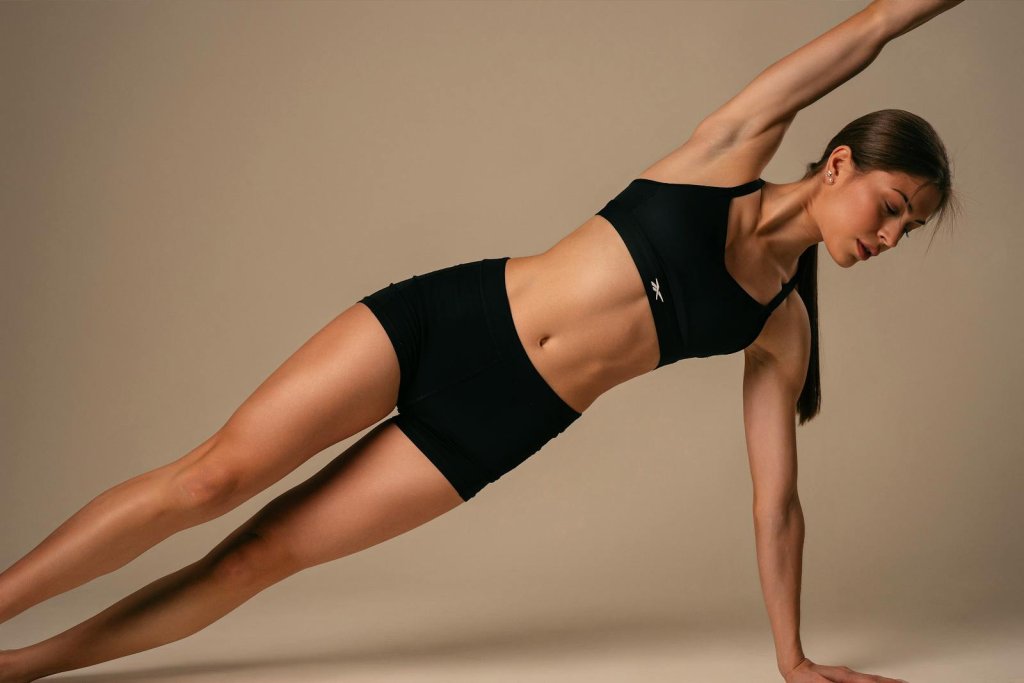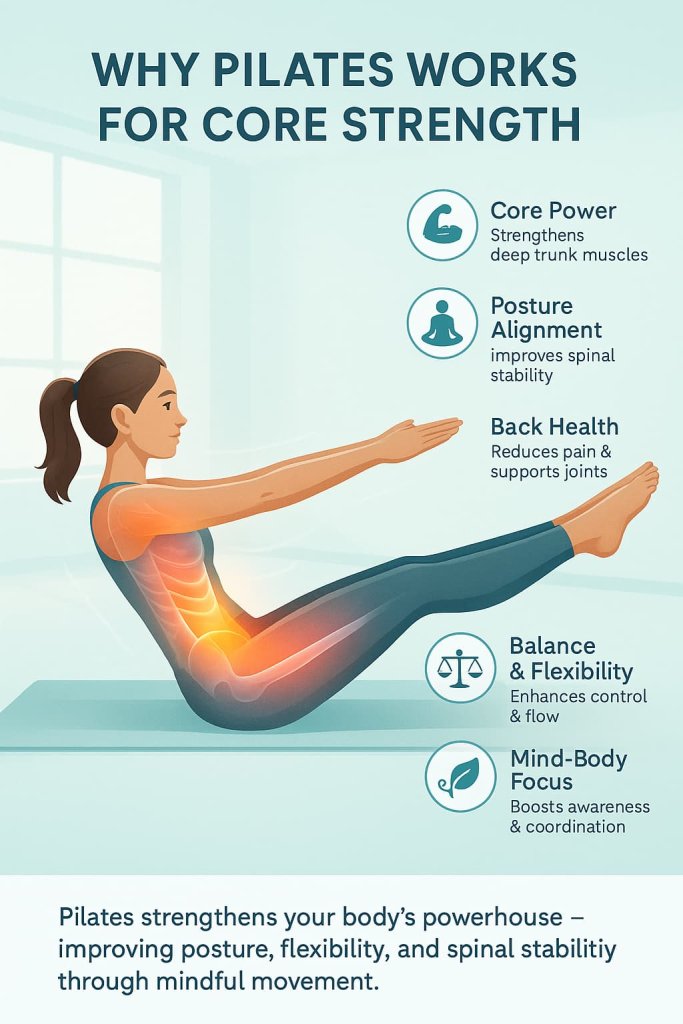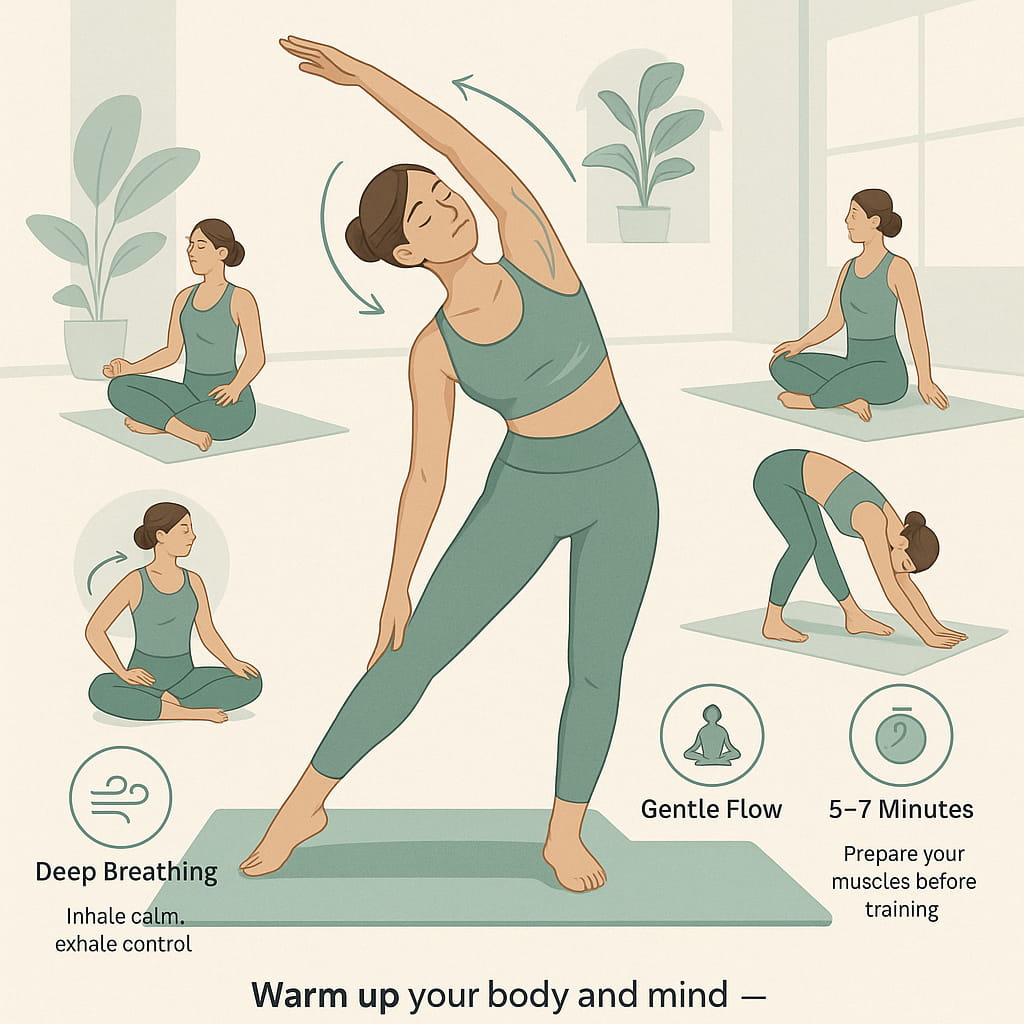Pilates is one of the most effective ways to build a strong, stable, and sculpted core — fast. It targets your deep abdominal muscles, improves posture, and enhances total-body balance. Whether you’re a beginner or advanced practitioner, these 12 Pilates core exercises can help you tone your abs, support your spine, and move with better control.

Understanding how Pilates strengthens your core is key: it engages not just the visible “six-pack” (rectus abdominis) but also the deep stabilizers — the transverse abdominis, obliques, diaphragm, and pelvic floor. Strengthening these muscles builds stability from the inside out, supporting everything from your posture to your athletic performance.
Why Pilates Works for Core Strength
According to a 2024 review in BMC Musculoskeletal Disorders, Pilates effectively improves core endurance, posture, and spinal stability by targeting deep trunk muscles through controlled movements and breathwork.
The American Council on Exercise (ACE) also confirms that consistent Pilates training enhances functional core strength and reduces lower back pain.

Key benefits include:
- Builds strong, lean abs without high-impact stress
- Improves posture and spinal alignment
- Reduces back pain and supports joint stability
- Enhances flexibility, coordination, and balance
- Boosts body awareness and mind–muscle connection
Warm-Up: Before You Begin

Before performing Pilates core exercises:
- Spend 5–7 minutes warming up with gentle stretches and breathing.
- Focus on drawing your navel toward your spine to engage your core.
- Move slowly — Pilates emphasizes precision, not speed.
- Avoid jerky motions to protect your lower back and joints.
12 Best Pilates Core Exercises
These 12 Pilates core exercises strengthen and sculpt your abs while improving posture, balance, and spinal support.
Each move targets deep stabilizing muscles to build total-body control and core endurance safely and effectively.
1. The Hundred
Why it works:
This foundational Pilates exercise builds heat in your body while engaging your entire core — from your deep transverse abdominis to your rectus abdominis. It also improves circulation, coordination, and endurance, making it the perfect warm-up for your ab routine.
Muscles worked:
Transverse abdominis, rectus abdominis, obliques, and hip flexors.
How to do it:
- Lie on your back with your knees bent into tabletop position.
- Lift your head, neck, and shoulders while extending your arms straight alongside your body.
- Stretch your legs out at a 45-degree angle.
- Begin pumping your arms up and down, inhaling for 5 counts and exhaling for 5 counts.
- Complete 10 breath cycles (total of 100 arm pumps).
Trainer Tip:
Keep your lower back pressed into the mat and focus on rhythmic breathing — precision is more important than speed.
2. Single-Leg Stretch
Why it works:
This movement strengthens your lower abs while improving hip mobility and coordination between breath and movement — key elements of Pilates control.
Muscles worked:
Lower abdominals, obliques, hip flexors.
How to do it:
- Lie on your back, knees bent toward your chest.
- Lift your head and shoulders off the mat, engaging your core.
- Extend your right leg out at a 45° angle while holding your left knee close to your chest.
- Switch legs in a smooth, controlled rhythm.
- Perform 10–12 repetitions per side.
Trainer Tip:
Keep your pelvis stable and avoid arching your lower back — think “navel to spine” throughout.
3. Double-Leg Stretch
Why it works:
Engages both the upper and lower abdominals at once, teaching control and core coordination. It’s a signature Pilates move for functional abdominal strength.
Muscles worked:
Rectus abdominis, transverse abdominis, and hip flexors.
How to do it:
- Begin in the same position as Single-Leg Stretch, with knees drawn in and head lifted.
- Inhale as you extend both legs and arms away from your body.
- Exhale as you sweep your arms around and pull your knees back in.
- Perform 8–10 controlled repetitions.
Trainer Tip:
Keep your ribs knitted together to avoid flaring — stability keeps your abs fully activated.
4. Roll-Up
Why it works:
Improves spinal mobility, strengthens your core, and replaces crunches with a more joint-friendly motion that builds control through the full range of motion.
Muscles worked:
Rectus abdominis, obliques, hip flexors, and spinal stabilizers.
How to do it:
- Lie flat with arms extended overhead and legs together.
- Inhale to lift your arms, exhale as you roll up one vertebra at a time to reach toward your toes.
- Slowly roll back down with control.
- Repeat 8–10 times.
Trainer Tip:
If you can’t reach up smoothly, slightly bend your knees or use a resistance band around your feet for support.
5. Criss-Cross
Why it works:
Sculpts the waistline by firing up your obliques and improving rotational strength and coordination.
Muscles worked:
Obliques, rectus abdominis, hip flexors.
How to do it:
- Lie on your back with your hands behind your head.
- Lift your head and shoulders off the mat.
- Bring your right elbow toward your left knee while extending your right leg.
- Switch sides in a controlled rhythm for 12–15 reps each.
Trainer Tip:
Keep your elbows wide and your shoulder blades off the mat — avoid pulling your neck.
6. Scissor Kick
Why it works:
Builds deep abdominal strength while improving hip flexibility and coordination between limbs.
Muscles worked:
Lower abdominals, hip flexors, inner thighs.
How to do it:
- Lie flat on your back with legs extended toward the ceiling.
- Hold one leg gently toward your chest while lowering the other leg just above the mat.
- Switch legs in a scissoring motion, exhaling as you switch.
- Perform 10–12 reps per side.
Trainer Tip:
Keep both legs active and straight — control the descent, don’t let gravity take over.
7. Leg Circles
Why it works:
This exercise challenges pelvic stability while working the lower abs and improving hip joint mobility.
Muscles worked:
Lower abs, hip flexors, inner and outer thighs.
How to do it:
- Lie flat with one leg extended on the floor and the other pointing toward the ceiling.
- Circle your raised leg clockwise for 5 reps, then counterclockwise for 5.
- Keep your hips square and still.
- Switch legs and repeat.
Trainer Tip:
Anchor your pelvis and engage your abs — your core should control the movement, not momentum.
8. Plank-to-Pike
Why it works:
Strengthens the entire core, especially the deep stabilizers, while also improving shoulder and upper-body control.
Muscles worked:
Transverse abdominis, shoulders, glutes, hamstrings.
How to do it:
- Start in a high plank position, hands under shoulders.
- Exhale and lift your hips up into a pike, forming an inverted “V.”
- Inhale and lower back into plank.
- Repeat for 10–12 slow, controlled reps.
Trainer Tip:
Keep your legs straight and core braced — avoid arching your back in the plank position.
9. Teaser
Why it works:
This advanced Pilates exercise improves coordination, balance, and full-core strength, demanding precise control and stability.
Muscles worked:
Rectus abdominis, obliques, hip flexors, and spinal erectors.
How to do it:
- Lie flat with arms overhead and legs extended.
- Exhale, lift your head and legs simultaneously, rolling up into a “V” shape.
- Hold for 2–3 seconds, then slowly roll down.
- Perform 6–8 repetitions.
Trainer Tip:
Engage your core deeply before lifting — imagine moving in one smooth, flowing piece.
10. Side Plank Leg Lift
Why it works:
Targets your obliques, glutes, and hips while improving lateral stability and balance — often neglected in traditional ab routines.
Muscles worked:
Obliques, gluteus medius, shoulders, core stabilizers.
How to do it:
- Start in a side plank on your forearm with legs stacked.
- Keep your hips lifted and lift your top leg slowly, then lower.
- Perform 8–10 reps per side.
Trainer Tip:
Avoid collapsing into your shoulder — press the forearm firmly into the mat and keep your body aligned.
11. Swan Prep
Why it works:
Balances front-core work by strengthening the spinal extensors and improving posture and back mobility.
Muscles worked:
Erector spinae, glutes, shoulders, and upper back.
How to do it:
- Lie face down with your palms beside your chest.
- Inhale and lift your chest gently off the mat, keeping your lower ribs grounded.
- Exhale and lower down with control.
- Perform 8–10 repetitions.
Trainer Tip:
Keep your neck long and relaxed — lead with your chest, not your chin.
12. Pilates Plank Hold
Why it works:
Develops endurance and strengthens the deep stabilizers of the core, helping protect your spine during all movement patterns.
Muscles worked:
Transverse abdominis, rectus abdominis, shoulders, glutes, quads.
How to do it:
- Begin on your forearms and toes, elbows under shoulders.
- Engage your abs, glutes, and legs, maintaining a straight line from head to heels.
- Hold for 30–60 seconds.
Trainer Tip:
Focus on steady breathing — inhale through your nose, exhale through your mouth. Avoid sagging hips or raised shoulders.
Safety and Progress Tips
- Start with 2–3 sessions per week and progress gradually.
- Focus on quality, not quantity — precise control builds strength faster.
- If you experience discomfort, consult a certified Pilates instructor.
Who Should Avoid Advanced Pilates Core Moves
While Pilates is generally safe for most people, certain individuals should avoid or modify advanced core exercises until they’ve built adequate strength, stability, and body awareness.
Avoid or modify advanced Pilates core moves if you:
- Have lower back pain, herniated discs, or recent spinal injuries.
- Are pregnant or recently postpartum, especially without medical clearance.
- Experience osteoporosis or osteopenia, as flexion-based moves (like Roll-Up or Teaser) may increase spinal strain.
- Have hip, shoulder, or neck injuries that limit full range of motion.
- Are new to exercise and haven’t yet developed core control or balance.
Safer approach:
Start with beginner-friendly mat exercises (like Pelvic Tilt, Dead Bug, and Modified Plank) and gradually progress under the guidance of a certified Pilates instructor or licensed physiotherapist.
If you experience pain, numbness, or discomfort, stop immediately and consult a healthcare professional. Pilates should challenge your core — not cause strain or pain.
FAQs
1. How often should I do Pilates core exercises?
2–4 times a week is ideal for strength and tone without overtraining.
2. Can Pilates give you visible abs?
Yes — when combined with a healthy diet and consistent practice, Pilates defines and flattens your abs.
3. Is Pilates better than crunches for core strength?
Yes. Pilates engages more stabilizing muscles, promoting better posture and balanced strength.
4. How long until I see results?
Most people notice improved core stability and tone within 4–6 weeks of consistent training.
5. Do I need equipment for these exercises?
No — all these moves can be done on a mat. A small ball or ring can add variety later.
Conclusion
Building a strong core isn’t just about aesthetics — it’s about stability, balance, and confidence in movement. Pilates offers a safe, effective way to sculpt your abs and support a healthier spine.
Start with these 12 moves, focus on mindful control, and you’ll feel stronger from your center out.
Ready to strengthen your core? Roll out your mat and begin your Pilates journey today.
This content is for informational purposes only and not medical advice.
References
- Patti A, et al. (2024). Effectiveness of Pilates Exercise on Low-Back Pain — Systematic Review & Meta-analysis.
Pilates reduces pain/disability vs. minimal care; supports safe core-focused programming.
Read on PubMed - Li F, et al. (2024). Effects of Pilates on Body Posture — Systematic Review.
Shows posture improvements across cervical, thoracic, and lumbar regions.
Read on PubMed - Fernández-Rodríguez R, et al. (2022). Network Meta-analysis of Exercise for Chronic Low Back Pain (JOSPT).
Ranks Pilates/mind-body/core-based exercise among effective options for pain/disability.
Read at JOSPT - NICE Guideline NG59 (current). Low-Back Pain and Sciatica in Over-16s — Assessment & Management.
UK clinical guidance recommending exercise-based care; aligns with Pilates programming.
Read at NICE - American College of Sports Medicine (ACSM) — Physical Activity Guidelines (current).
Evidence-based weekly frequency/strength guidelines to frame Pilates core frequency.
Read at ACSM - Harvard Health Publishing (2024). Want a stronger core — skip the sit-ups.
Medical-school guidance emphasizing plank/stability work over crunches.
Read at Harvard Health - NHS — Pilates for Beginners (video & guide).
Trusted public-health resource with safe, modifiable mat-Pilates instruction.
Read/Watch at NHS - ACE (American Council on Exercise) — How to Do the Pilates Hundred (technique & breathing).
Authoritative technique cues for a core staple used in your plan.
Read at ACE
